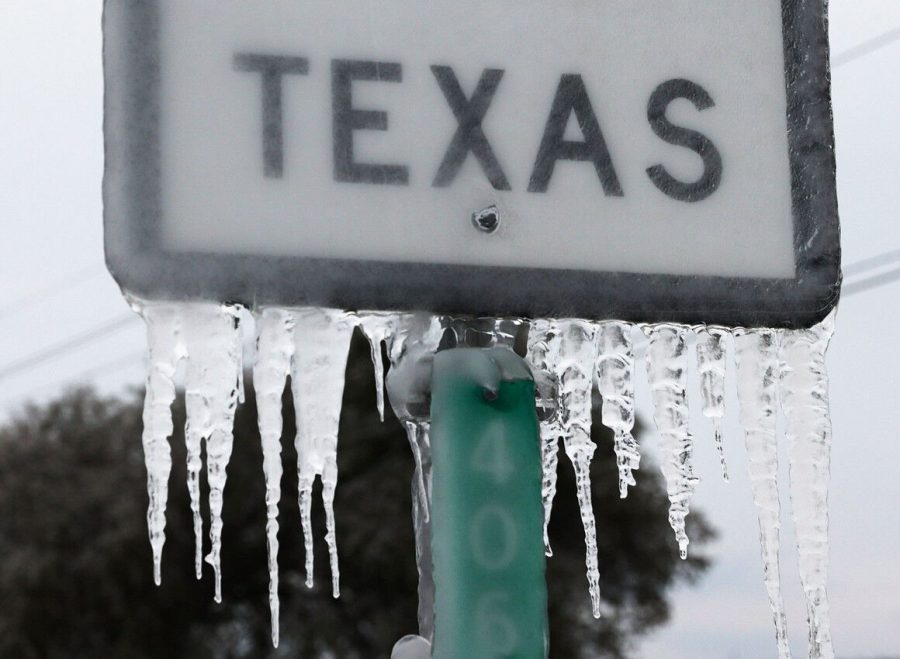Devastation in Texas Raises Concerns Nationwide
Courtesy of Joe Raedle/Getty Images.
Unprecedented winter weather ravaged Texas, bringing record-low temperatures and exposing systemic failures.
February 24, 2021
In the past week, unprecedented winter weather ravaged the southern U.S., bringing record-low temperatures, massive snowfall and—in the state of Texas in particular— the revelation of statewide failures in energy infrastructure and emergency preparedness.
As temperatures dropped to historic lows on Feb. 14, Texans across the state cranked up their thermostats and, almost immediately, the energy grid struggled to maintain power amidst the exceptional demand. In the following days, millions were left without electricity in subfreezing temperatures. Several factors contributed to the massive system failure, one of the most notable being Texas’ isolated and fully deregulated power market.
The independence of Texas’s energy grid is ultimately rooted in the state’s historical priority to avoid federal overreach into state sovereignty. In the words of Texas Tribune columnist Kate Galbraith, “Texas’ secessionist inclinations have at least one modern outlet: the electric grid.”
State utility officials throughout the 20th century consciously avoided linking Texas’s grid across state lines (a break from the national norm, as almost all other states commonly import and export their energy supply beyond their borders) to remain outside the jurisdiction of the Federal Energy Regulatory Commission (FERC). To this day, Texas is not subject to FERC regulations, instead managed by the Electric Reliability Council of Texas, or ERCOT. The uniquely independent electric grid and system allowed for its fairly seamless deregulation about two decades ago by the state legislature.
Texas’s energy deregulation began in 1999, phasing out the previously existing vertically integrated public energy utilities in exchange for retail competition. To understand what is so different about this system, it’s important to note the three main parts of the energy-providing process: generation providers who generate the electricity, transmission owners who maintain the infrastructure responsible for transmitting energy from providers to customers and retail companies who sell electricity to the public.
The public utility companies present in Texas pre-1999 still remain prevalent in other parts of the country today and consolidate those three parts within one entity, which controls the production, transportation and pricing of power in the state. Following deregulation, however, those components were largely split apart, and priorities shifted from power store dependability to cost efficiency.
Though at times it brings Texans positive outcomes (most notably including cheaper average electricity prices for the state), the preference toward self-sufficiency and market competition in the energy sector showed a much more negative side last week. Despite the obvious disadvantages, several Texan Republicans, including former Texas governor and U.S. Secretary of Energy Rick Perry, insisted that the benefits of the system outweighed its risks.
“Texans would be without electricity for longer than three days to keep the federal government out of their business,” Perry said in a blog posted by the office of House Minority Leader Kevin McCarthy on Feb. 17.
Actual sentiments from Texans seem to refute claims like Perry’s, however. There is statewide outrage toward the massive power outages largely caused by the deregulated energy model, specifically in that providers along all steps of the supply chain elected against weather-proofing infrastructure in the past. Such preventative measures are common, and even mandated, in other states where the government controls energy production and distribution, but deregulation in the Lone Star State allowed providers to bypass this step.
Consequently, plunging temperatures and icy conditions brought several areas of energy production to a grinding halt—energy sources themselves including wind turbines, solar panels, natural gas stores and coal energy generators, literally froze over, along with the pipelines responsible for transporting energy resources from production sites in west Texas to regions with high demand.
Thus, when low temperatures set in, the ERCOT grid experienced a simultaneous shrinking supply aside a surge in demand. With no ability to quickly syphon out-of-state energy, ERCOT chose to implement rolling outages to avoid a statewide blackout.
The controlled blackouts lasted throughout the week and were much longer than ERCOT originally promised, with many going without any power for days on end. The effects were devastating.
For one, carbon monoxide poisoning cases and deaths increased immensely as many without power attempted to stay warm amid sub-zero temperatures by running their cars in enclosed spaces. Additionally, there were numerous reports of deadly house fires caused by families trying to generate warmth through wood fires in homes without wood-burning fireplaces. Drinking water systems, too, were knocked offline in many parts of the state.
Additionally, there were dozens of deaths statewide relating to exposure to the extreme conditions without accessible ways to find warmth. The city of Galveston—which saw a 60-hour blackout early in the week—requested refrigerated trucks to deal with dwindling capacity in county morgues, citing a need for additional capacity for 20 to 50, showcasing the scale of devastation caused by the storm and power outages.
Local Galveston officials, like County Judge Mark Henry, and other state leaders expressed harsh criticism toward ERCOT and the rolling blackouts.
“What we quickly found out was they weren’t rolling at all,” Henry said. “They went off and they have stayed off for as much as 48 hours at this point and counting. This is unacceptable. It’s not like they didn’t know this was coming. The ice storm was in the forecast for at least a week prior to the event.”
Indeed, assignments of blame have been prevalent in the days during and following the system breakdown, with many politicians using the storm as a platform for political posturing on a variety of issues. Texas Governor Greg Abbott, for example, initially blamed renewable energy like wind and solar for the failure.
“It just shows that fossil fuel is necessary for the state of Texas as well as other states to make sure we will be able to heat our homes in the winter times and cool our homes in the summer times,” Abbott said in a Feb. 16 interview on Fox News.
This was a common sentiment among other notable Texas Republicans, including Agriculture Commissioner Sid Miller and U.S. House Representative Dan Crenshaw.
“This is what happens when you force the grid to rely in part on wind as a power source,” Crenshaw tweeted. “When weather conditions get bad as they did this week, intermittent renewable energy like wind isn’t there when you need it.”
However, in reality, all energy sources—renewable and otherwise—failed across the board. In fact, according to ERCOT representative Dan Woodfin, gas shoulders more blame than renewable energy for the breakdown.
“It appears that a lot of the generation that has gone offline today has been primarily due to issues on the natural gas system,” Woodfin said in a Feb. 16 press call
Alongside conspiratorial arguments about clean energy, there has been prevalent discussion of the grim situation in Texas as a reflection of climate change and evidence that the nation at large is underprepared to respond to consequent extreme weather events, which scientists report will become more and more common in years to come. This sentiment was echoed by federal officials like White House homeland security adviser and national security advisor Elizabeth Sherwood-Randall.
“The extreme weather events that we’re experiencing this week across the central, southern and now the eastern United States do yet again demonstrate to us that climate change is real, and it’s happening now, and we’re not adequately prepared for it,” Sherwood-Randall said in a Feb. 18 White House press briefing.
Sherwood-Randall, who also served as deputy secretary of energy during the Obama administration, cited overhauls to energy infrastructure to ward against and in response to climate change as a major goal of the Biden team.
The future remains uncertain for Texans, many of whom now face a water crisis even as electricity has been widely restored across the state. The causes and effects of the devastation, along with the operations of ERCOT in particular, are under active investigation ordered by Gov. Abbott, and critical debate surrounding the implications and politicization of climate change seems unavoidable following the utter ruin in Texas.



